Discover 35 hidden attractions, cool sights, and unusual things to do in New Haven (United States). Don't miss out on these must-see attractions: Peabody Museum of Natural History, Yale University Art Gallery, and East Rock Park. Also, be sure to include Yale Center for British Art in your itinerary.
Below, you can find the list of the most amazing places you should visit in New Haven (Connecticut).
Table of Contents
Peabody Museum of Natural History
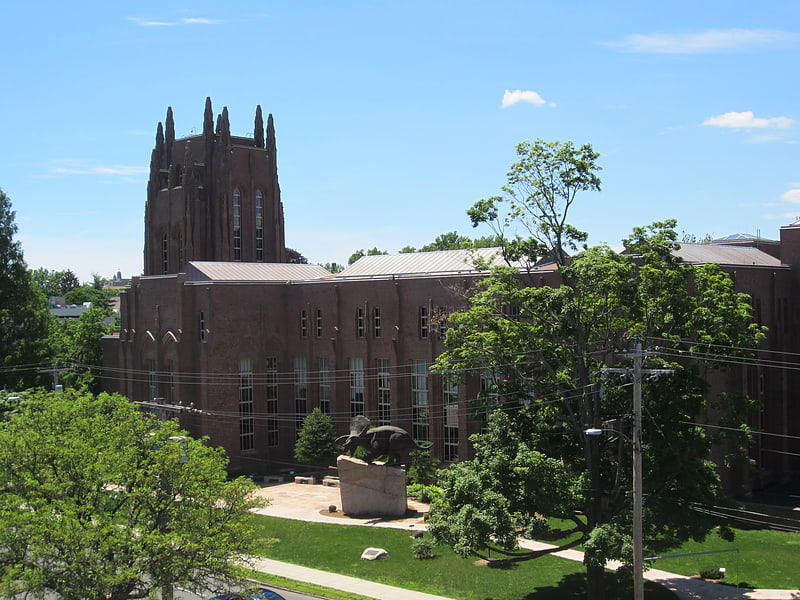
Museum in New Haven, Connecticut. The Peabody Museum of Natural History at Yale University is among the oldest, largest, and most prolific university natural history museums in the world. It was founded by the philanthropist George Peabody in 1866 at the behest of his nephew Othniel Charles Marsh, the early paleontologist. Most known to the public for its Great Hall of Dinosaurs, which includes a mounted juvenile Brontosaurus and the 110-foot-long mural The Age of Reptiles, it also has permanent exhibits dedicated to human and mammal evolution; wildlife dioramas; Egyptian artifacts; and the birds, minerals and Native Americans of Connecticut.[1]
Address: 170 Whitney Ave, 06511 New Haven (Central New Haven)
Yale University Art Gallery
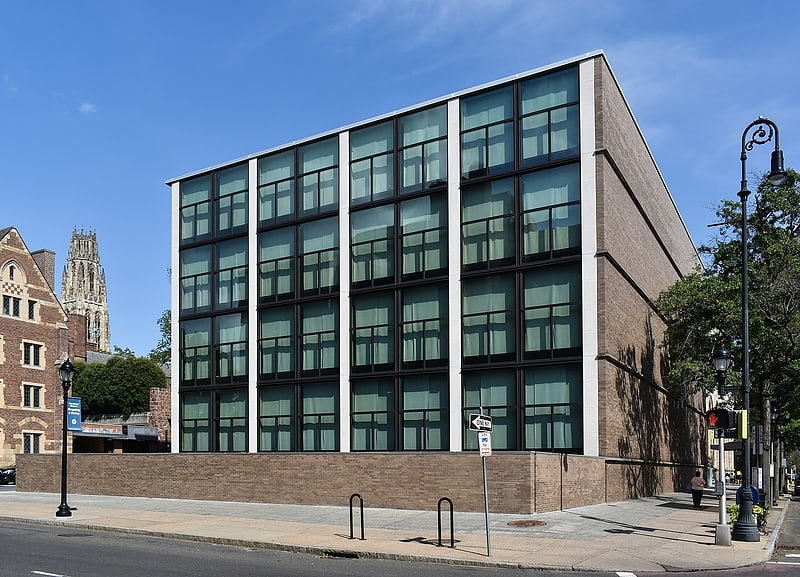
Museum in New Haven, Connecticut. The Yale University Art Gallery is the oldest university art museum in the Western Hemisphere. It houses a major encyclopedic collection of art in several interconnected buildings on the campus of Yale University in New Haven, Connecticut. Although it embraces all cultures and periods, the gallery emphasizes early Italian painting, African sculpture, and modern art.[2]
Address: 1111 Chapel St, 06510 New Haven (Central New Haven)
East Rock Park
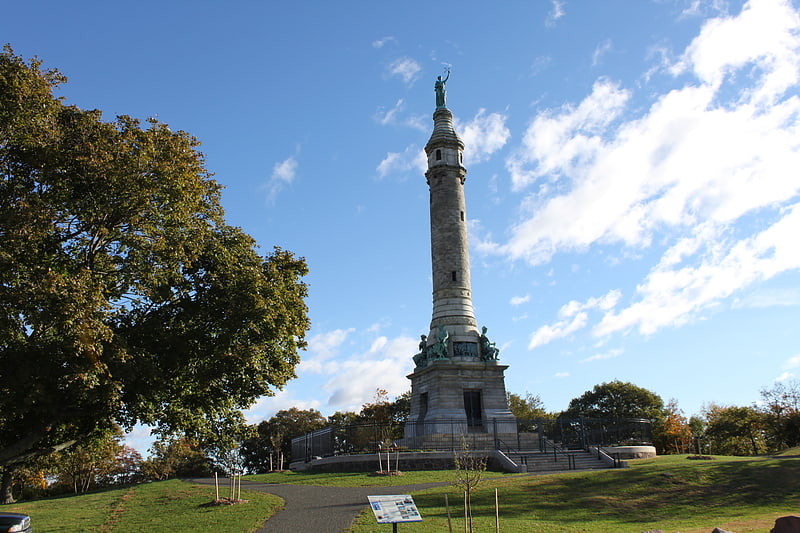
Park in New Haven County, Connecticut. East Rock Park is a park in the city of New Haven and the town of Hamden, Connecticut that is operated as a New Haven city park. The park surrounds and includes the mountainous ridge named East Rock and was developed with naturalistic landscaping. The entire 427-acre park is listed on the National Register of Historic Places.[3]
Yale Center for British Art
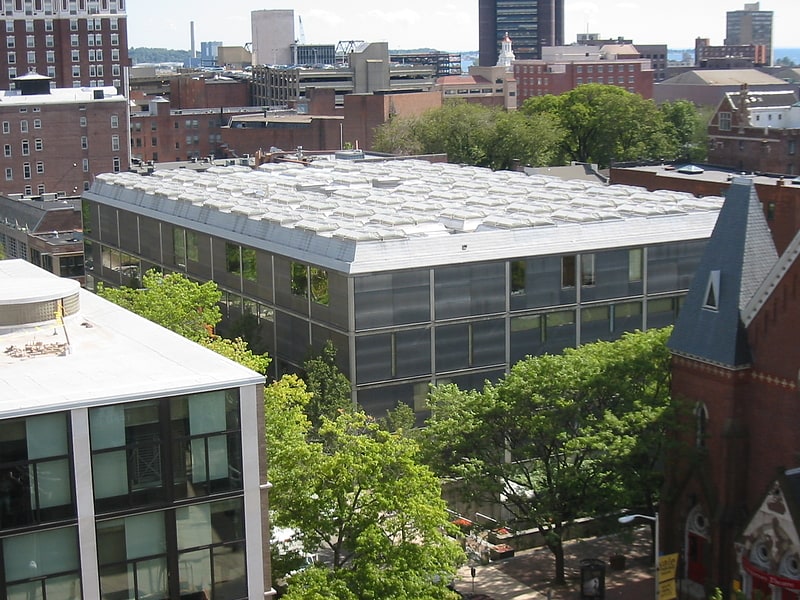
Collection of 16th- to 19th-century art. The Yale Center for British Art at Yale University in downtown New Haven, Connecticut, houses the largest and most comprehensive collection of British art outside the United Kingdom. The collection of paintings, sculpture, drawings, prints, rare books, and manuscripts reflects the development of British art and culture from the Elizabethan period onward.[4]
Address: New Haven, 1080 Chapel Street
Old Campus
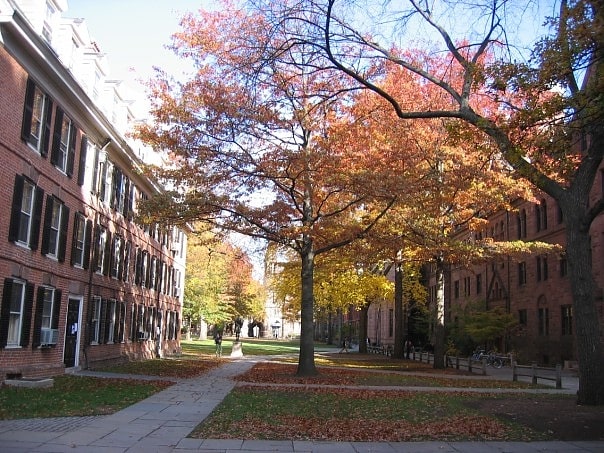
Building complex. The Old Campus is the oldest area of the Yale University campus in New Haven, Connecticut. It is the principal residence of Yale College freshmen and also contains offices for the academic departments of Classics, English, History, Comparative Literature, and Philosophy. Fourteen buildings—including eight dormitories and two chapels—surround a 4-acre courtyard with a main entrance from the New Haven Green known as Phelps Gate.
The Old Campus comprised most of Yale College's grounds between its arrival in New Haven in 1718 and its 20th-century expansion. Yale's first building in New Haven, the College House, was erected in 1718 on the Old Campus' southeast corner, fulfilling the city founders' wish to have a college near New Haven's Congregational church. It was joined by Connecticut Hall in 1750, a student dormitory and Yale's only surviving building from the colonial era. A linear building plan established in 1792, known as Old Brick Row, was the first campus plan in the United States and became a template for many American college campuses built in the 19th century. After 1870, the original plan gave way to the current quadrangle of dormitories, academic buildings, and chapels.
In addition to Connecticut Hall, the current buildings of Old Campus include most of the freshman dormitories of Yale College, Street Hall of the Yale University Art Gallery, and two buildings used for religious purpose: Battell Chapel, third in a succession of college chapels, and Dwight Hall, formerly the College Library. Although the current buildings have been renovated and their uses changed during the twentieth century, all were completed before 1928.[5]
Lighthouse Point Carousel
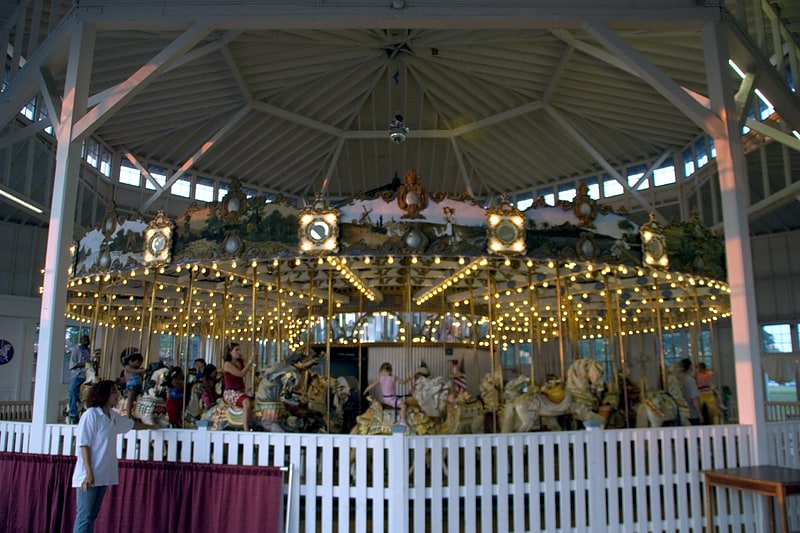
The Lighthouse Point Carousel is located in the East Shore section of New Haven, Connecticut in Lighthouse Point Park. The carousel was built about 1905, and is one of a shrinking number of early 20th-century carousels left in the state, featuring the carvings of Charles Looff and Charles Carmel. The carousel and its 1916 building were together listed on the National Register of Historic Places on December 15, 1983.[6]
Address: Lighthouse Rd, 06512 New Haven
Yale School of Art
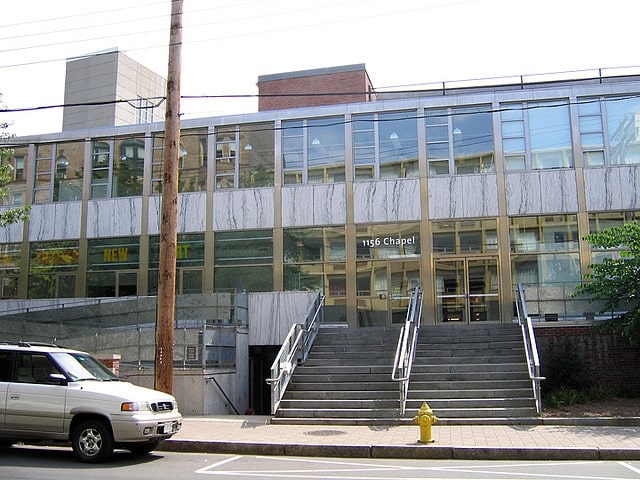
Art school in New Haven, Connecticut. The Yale School of Art is the art school of Yale University. Founded in 1869 as the first professional fine arts school in the United States, it grants Masters of Fine Arts degrees to students completing a two-year course in graphic design, painting/printmaking, photography, or sculpture.
U.S. News & World Report's 2012 and 2013 rankings rated Yale first in the United States for its Masters of Fine Arts programs. The Yale Daily News reported in February 2007 that 1,215 applicants for its class of 2009 sought admission to 55 places. The Yale Alumni Magazine reported in November 2008 that the School admitted sixty-five applicants from among 1,142 for its class of 2010, and that fifty-six enrolled.
Any student applying to the school must have an exceptional undergraduate record as well as a complete body of work for presentation. This is further followed by an essay and recommendations. The complete process for an applicant requires great preparation and the process must be completed in accordance with strict guidelines established by the school.[7]
Address: 1156 Chapel St, 06511 New Haven (Central New Haven)
New Haven Green

Park in New Haven, Connecticut. The New Haven Green is a 16-acre privately owned park and recreation area located in the downtown district of the city of New Haven, Connecticut. It comprises the central square of the nine-square settlement plan of the original Puritan colonists in New Haven, and was designed and surveyed by colonist John Brockett. Today the Green is bordered by the modern paved roads of College, Chapel, Church, and Elm streets. Temple Street bisects the Green into upper and lower halves.
The green is host to numerous public events, such as the International Festival of Arts and Ideas and New Haven Jazz Festival, summer jazz and classical music concerts that can draw hundreds of thousands of people, as well as typical daily park activities. The New Haven Green Historic District was designated a National Historic Landmark District for the architectural significance of the three 19th-century churches located there.
The New Haven Green is one of the oldest and most well-known town greens in the nation, dating back to at least 1638. As of July 2017, the City of New Haven offers free public WiFi on the Green.[8]
Address: Temple Street, 06511 New Haven (Central New Haven)
Grove Street Cemetery
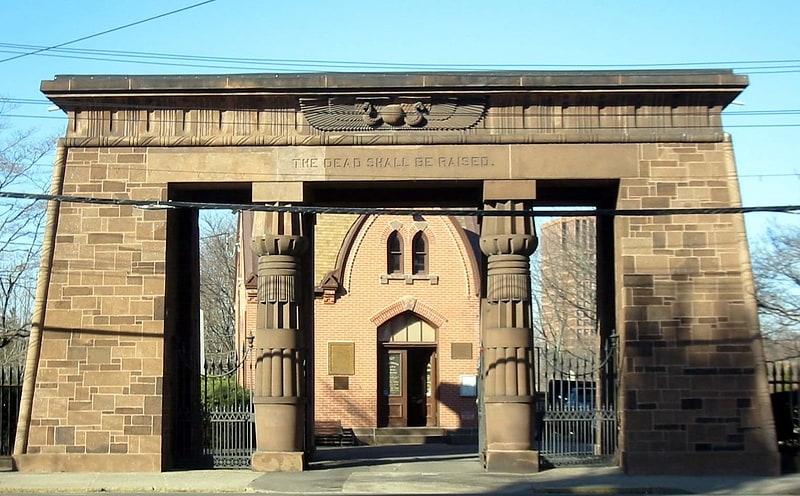
Landmark cemetery with graves of famous. Grove Street Cemetery or Grove Street Burial Ground is a cemetery in New Haven, Connecticut, that is surrounded by the Yale University campus. It was organized in 1796 as the New Haven Burying Ground and incorporated in October 1797 to replace the crowded burial ground on the New Haven Green. The first private, nonprofit cemetery in the world, it was one of the earliest burial grounds to have a planned layout, with plots permanently owned by individual families, a structured arrangement of ornamental plantings, and paved and named streets and avenues. By introducing ideas like permanent memorials and the sanctity of the deceased body, the cemetery became "a real turning point.. a whole redefinition of how people viewed death and dying", according to historian Peter Dobkin Hall. Many notable Yale and New Haven luminaries are buried in the Grove Street Cemetery, including 14 Yale presidents; nevertheless, it was not restricted to members of the upper class, and was open to all.
In 2000, Grove Street Cemetery was designated a National Historic Landmark.
Today, it is managed by Camco Cemetery Management.[9]
Address: 227 Grove St, 06511-6806 New Haven (Central New Haven)
Soldiers' and Sailors' Monument

War memorial in New Haven, Connecticut. The Soldiers' and Sailors' Monument is a war memorial located on the 366-foot summit of East Rock in New Haven, Connecticut. It is visible for miles from the surrounding area and Long Island Sound. The monument was completed in 1887 and honors the residents of New Haven who gave their lives in the Revolutionary War, the War of 1812, the Mexican War, and the Civil War. It is 112 feet high and 87 steps to the top.[10]
Address: English Dr, 06511 New Haven (Hamden)
Five Mile Point Light
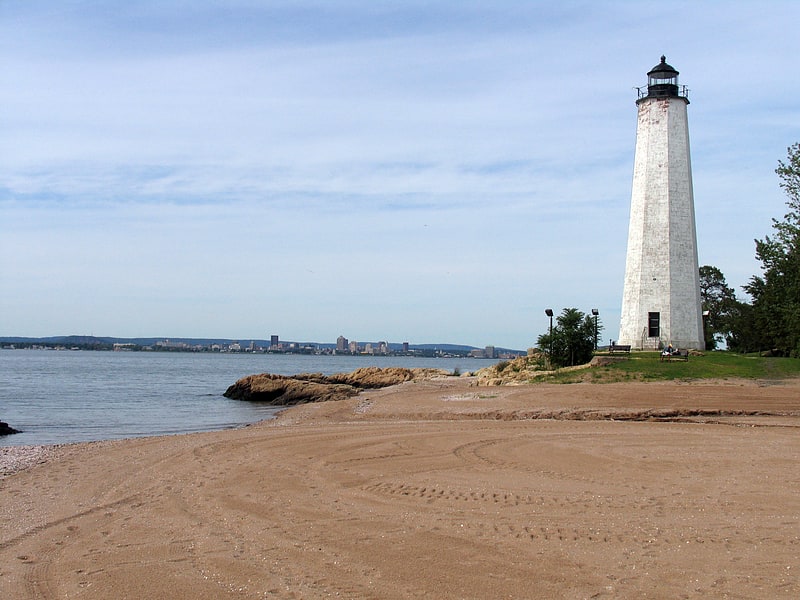
Lighthouse in New Haven, Connecticut. Five Mile Point Light, also known as Five Mile Point Lighthouse or Old New Haven Harbor Lighthouse, is a U.S. lighthouse in Long Island Sound on the coast of New Haven, Connecticut. Located at the entrance to New Haven Harbor, the beacon's name derives from its proximity to Downtown New Haven, about five miles away. The original lighthouse consisted of a 30-foot octagonal wooden tower built in 1805 by Abisha Woodward. In 1847, a new 80-foot octagonal tower was constructed by Marcus Bassett with East Haven brownstone. This new beacon was illuminated by 12 lamps with reflectors which were positioned 97 feet above sea level. Also constructed at this time was a two-and-one-half story brick house which supplanted the previous, deteriorating keeper's dwelling. A fourth-order Fresnel lens replaced the lamps in 1855 and a fog bell was added in the 1860s. The Five Mile Point Light was deactivated in 1877 when the nearby Southwest Ledge Light was completed. Currently, the lighthouse is contained within Lighthouse Point Park and, along with the keeper's house, was listed on the National Register of Historic Places in 1990.[11]
Address: Lighthouse Point Park - 2 Lighthouse Road, 06512 New Haven
East Rock
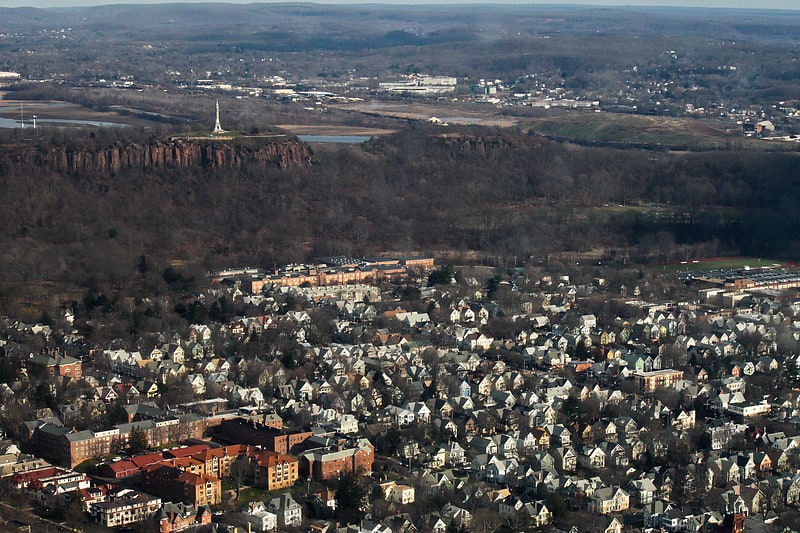
Geographical feature. East Rock of south-central Connecticut, United States, with a high point of 366 feet, is a 1.4-mile long trap rock ridge located primarily in the neighborhood of East Rock on the north side of the city of New Haven. A prominent landscape feature and a popular outdoor recreation area with cliffs that rise 300 feet over the city below, East Rock is part of the narrow, linear Metacomet Ridge that extends from Long Island Sound near New Haven, north through the Connecticut River Valley of Massachusetts to the Vermont border. East Rock is the central feature of East Rock Park, a municipal park owned by the city of New Haven along the New Haven-Hamden town line.[12]
Address: Cold Spring and Orange Sts, 06510 New Haven (Hamden)
Branford College
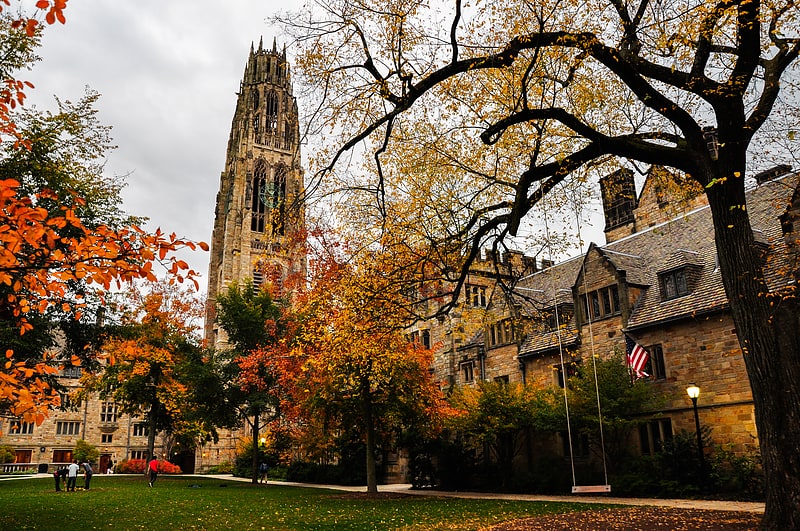
College in New Haven, Connecticut. Branford College is one of the 14 residential colleges at Yale University.[13]
Battell Chapel

Chapel in New Haven, Connecticut. Battell Chapel is the largest chapel of Yale University in New Haven, Connecticut. Built in 1874–76, it was funded primarily with gifts from Joseph Battell and others of his family. Succeeding two previous chapel buildings on Yale's Old Campus, it provided space for daily chapel services, which were mandatory for Yale College students until 1926. Together with Durfee Hall and Farnam Hall, the chapel was part of a program begun in the 1870s to build up the perimeter of Old Campus and separate it from the rest of the city. These three buildings, all by the same architect, were among the first at Yale to be named for donors rather than function, location, or legislative funding.
Battell Chapel is one of the locations on the Connecticut Freedom Trail.[14]
Address: New Haven, 400 College Street
Wooster Square
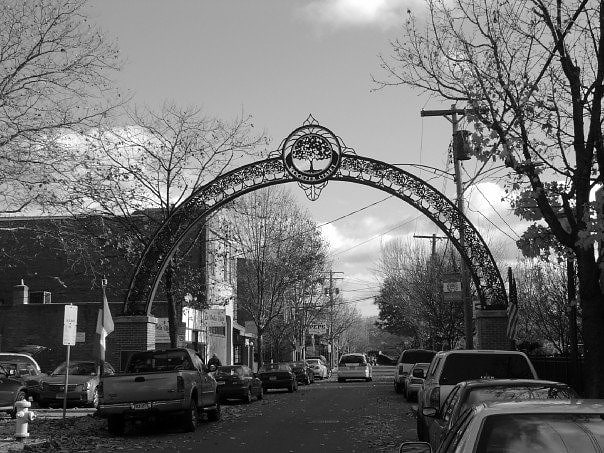
Neighborhood in New Haven, Connecticut. Wooster Square is a neighborhood in the city of New Haven, Connecticut to the east of downtown. The name refers to a park square located between Greene Street, Wooster Place, Chapel Street and Academy Street in the center of the neighborhood. Wooster Square is also known as Little Italy: a bastion of Italian American culture and cuisine, and is home to some of New Haven's, best-known pizza eateries, including Frank Pepe Pizzeria Napoletana and Sally's Apizza. The square and much of the neighborhood are included in the Wooster Square Historic District, which was listed on the National Register of Historic Places in 1971.
An annual Cherry Blossom Festival in Wooster Square Park commemorates the planting of 72 Yoshino Japanese cherry blossom trees in 1973 by the New Haven Historic Commission in collaboration with the New Haven Parks Department and neighborhood residents. The festival, founded and organized by the Historic Wooster Square Association, has grown from a modest event in the early 1970s with a local band entertaining a handful of neighbors under lighted trees to a major New Haven event that in 2016 attracted over 10,000 visitors.[15]
Silliman College

Residential college. Silliman College is a residential college at Yale University in New Haven, Connecticut, named for scientist and Yale professor Benjamin Silliman. It opened in September 1940 as the last of the original ten residential colleges, and contains buildings constructed as early as 1901.
Silliman is Yale's largest residential college by its footprint, occupying most of a city block. Due to its size, the college is able to house its freshmen in the college instead of on Yale's Old Campus. The college's architecture is eclectic: though architect Otto Eggers completed most of the college with Georgian buildings, the college also incorporates two early-20th century buildings in the French Renaissance and Gothic Revival styles.
The College has links to Harvard's Pforzheimer House and Dudley House, as well as Trinity College, Cambridge and Brasenose College, Oxford. Its rival college at Yale is Timothy Dwight College, located directly across Temple Street.[16]
Address: 505 College St, New Haven (Central New Haven)
Berkeley College
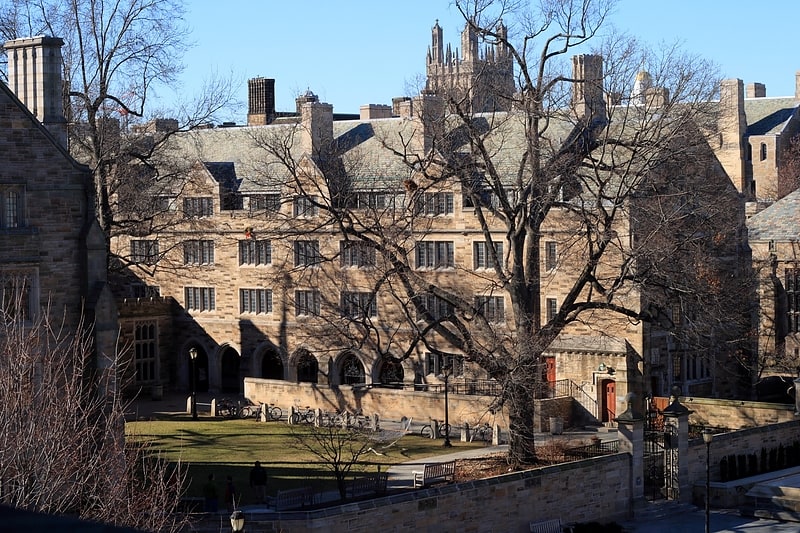
College in New Haven, Connecticut. Berkeley College is a residential college at Yale University, opened in 1934. The eighth of Yale's 14 residential colleges, it was named in honor of Reverend George Berkeley, dean of Derry and later bishop of Cloyne, in recognition of the assistance in land and books that he gave to Yale in the 18th century. Built on the site of a group of buildings known from the 1890s until 1933 as the Berkeley Oval, the college was renovated in 1998.[17]
Address: 205 Elm St, 06511 New Haven (Central New Haven)
Woolsey Hall
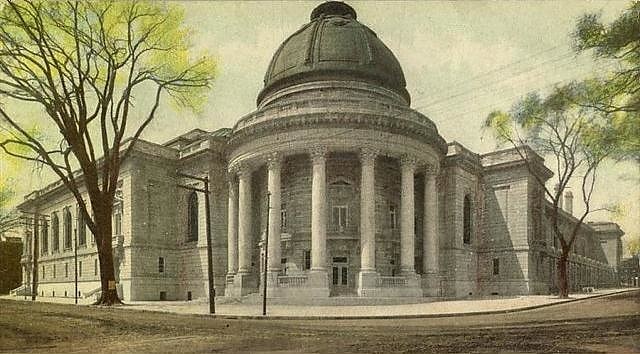
Auditorium in New Haven, Connecticut. Woolsey Hall is the primary auditorium at Yale University, located on the campus' Hewitt Quadrangle in New Haven, Connecticut. It was built as part of the Bicentennial Buildings complex that includes the Memorial Rotunda and the University Commons, designed by the firm Carrère and Hastings for the Yale bicentennial celebration in 1901. With approximately 2,650 seats, it is the university's largest auditorium and hosts concerts, performances, and university ceremonies including the annual freshman convocation, senior baccalaureate, and presidential inaugurations. The building is named for Theodore Dwight Woolsey, President of Yale from 1846 through 1871.[18]
Address: 500 College St, 06511-8962 New Haven (Central New Haven)
Nathan Hale Park
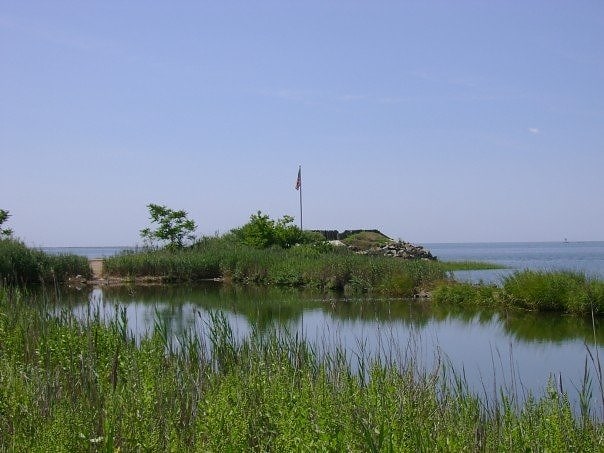
Historical landmark in New Haven, Connecticut. Fort Nathan Hale, also known as Fort Hale Park, Black Rock, is a 20-acre city park located on the east shore of New Haven Harbor in New Haven, Connecticut. It includes the site of a 1659 fort, a Revolutionary War-era fort, and a Civil War-era fort. The fort was named after Nathan Hale, Connecticut's official hero. Since 1921, the site has been owned by the state of Connecticut. It has been used as a park and maintained as a historical site by the City of New Haven. Educational programs are given throughout the year to students attending local schools.
The site was listed on the National Register of Historic Places in 1970. In 1970 the listing included three contributing buildings, one contributing site, and three contributing structures.[19]
Address: Fort Hale Park Rd, New Haven
Pirelli Tire Building
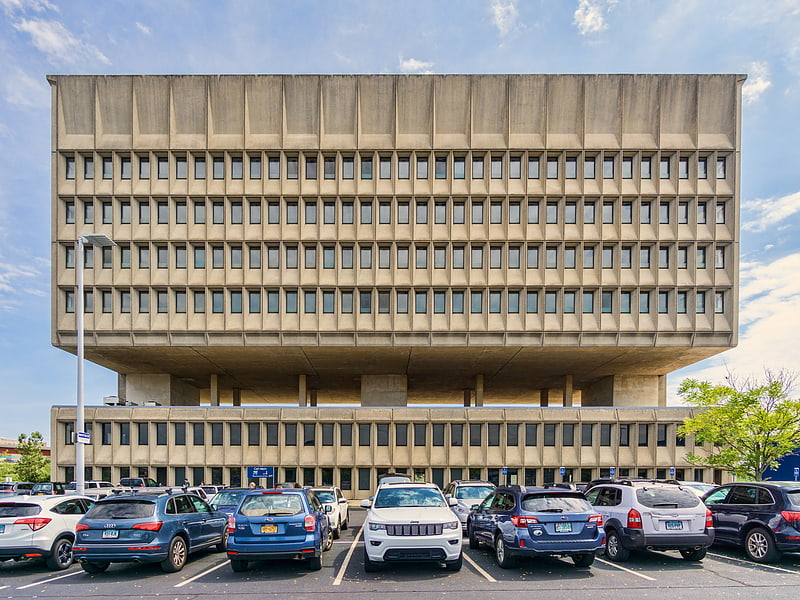
The Pirelli Tire Building also known as the Armstrong Rubber Building is a historic former office building in the neighborhood of Long Wharf in New Haven, Connecticut, USA. Designed by modernist architect Marcel Breuer, the structure is a noted example of Brutalism and was completed in 1970. Conversion to a hotel commenced in 2020 and it will open in the spring of 2022 as Hotel Marcel. The building was listed on the National Register of Historic Places in 2021.[20]
Address: 500 Sargent Drive, New Haven (South New Haven)
St. Stanislaus Parish

Catholic church in New Haven, Connecticut. St. Stanislaus Parish, designated for Polish immigrants in New Haven, Connecticut, United States, was founded on December 28, 1901. It is one of the Polish-American Roman Catholic parishes in New England in the Archdiocese of Hartford.[21]
Address: 9 Eld Street, New Haven (North New Haven)
Q Bridge
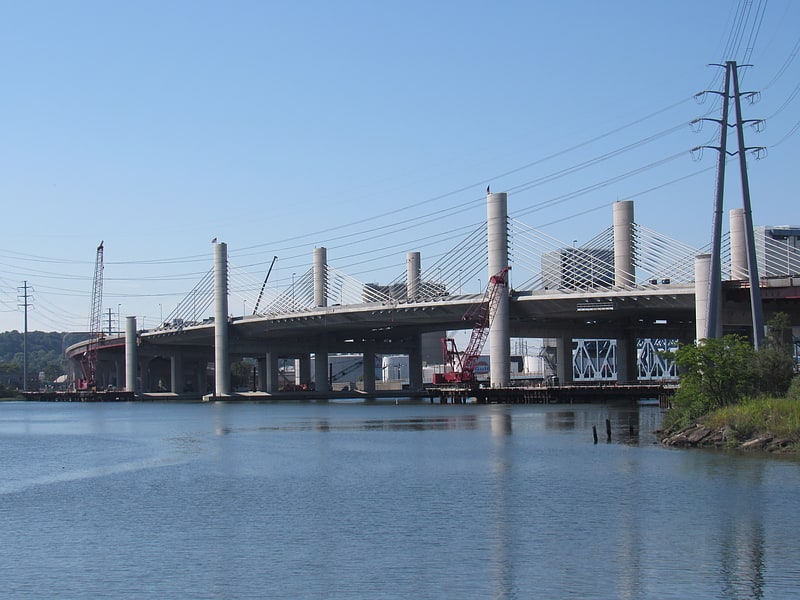
Extradosed bridge in New Haven, Connecticut. The Pearl Harbor Memorial Bridge, commonly referred to as the Q Bridge by locals, is an extradosed bridge that carries Interstate 95 over the mouth of the Quinnipiac River in New Haven, in the U.S. state of Connecticut. This bridge replaced the original 1,300 m span which opened on January 2, 1958. The old bridge had a girder and floorbeam design where steel beams supported a concrete bridge deck that carried three lanes of traffic in each direction with no inside or outside shoulders. The bridge was officially dedicated as the Pearl Harbor Memorial Bridge in 1995 to commemorate the attack on Pearl Harbor.
The old Pearl Harbor Memorial Bridge was replaced by a $554 million 10-lane extradosed bridge; the northbound span of which opened to traffic on June 22, 2012. Southbound traffic was shifted onto the new bridge, sharing the northbound span with northbound traffic until the new southbound span was completed in late 2015. Since the Gibbs Street Bridge in Portland, Oregon was redesigned from an extradosed span to a box girder bridge, the Pearl Harbor Memorial Bridge was the first extradosed bridge completed in the United States when it fully opened in September 2015. The new bridge is the centerpiece of a $2 billion megaproject called the New Haven Harbor Crossing Improvement Program.[22]
Chapel Street Historic District
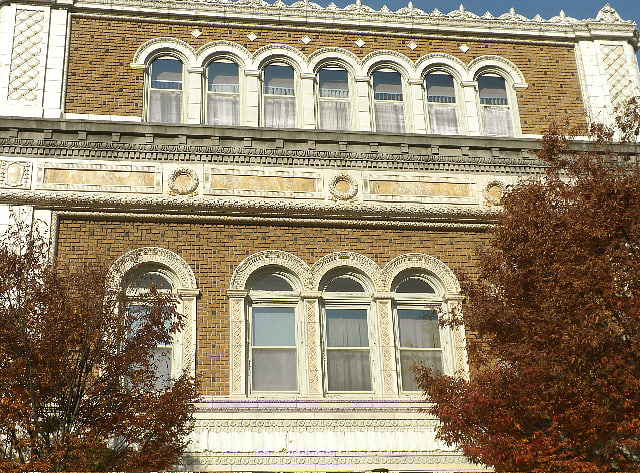
The Chapel Street Historic District is a 23-acre historic district in the Downtown New Haven area of the city of New Haven, Connecticut. It was listed on the National Register of Historic Places in 1984. The district covers the southwestern corner of Downtown New Haven, including properties from Park Street to Temple Street between Chapel and Crown streets, and properties from High Street to Temple Street between George and Crown streets. It is bordered on the north by the New Haven Green and the Yale University campus. The western edge borders the Dwight Street Historic District. The eastern and southern edges of the district abut areas of more modern development.
In 1984 the district included, over a 5 and a half block area, 102 buildings, of which 76 were contributing buildings. The predominantly brick structures represent a wide range of architectural styles. Maps show that the area was residential in the eighteenth century and through the first quarter of the nineteenth century. Commercial development began to take over at that time, though residential properties remained well represented. The oldest building in the district is the Ira Atwater House, built in 1817. Most of the buildings now in the district were built in the late nineteenth and early twentieth centuries, having replaced earlier residential and commercial development. One of the oldest surviving commercial buildings in the city is a c. 1831 building on Church Street. There are three church buildings in the district, including the former Calvary Church Baptist Church (1871) which now house the Yale Repertory Theatre.[23]
Saybrook College
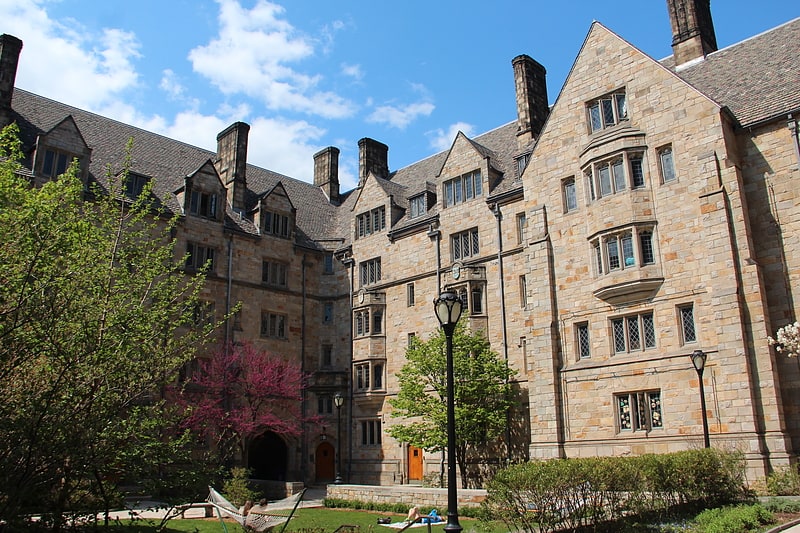
College in New Haven, Connecticut. Saybrook College is one of the 14 residential colleges at Yale University. It was founded in 1933 by partitioning the Memorial Quadrangle into two parts: Saybrook and Branford.
Unlike many of Yale's residential colleges that are centered on one large courtyard, Saybrook has two courtyards—one stone and one grass, hence the college cheer beginning "Two courtyards, stone and grass: two courtyards kick your ass."
Saybrook College was one of the original Yale Residential Colleges. Its name comes from the original location of the university, Old Saybrook, Connecticut. The college has the second highest student-to-land-area ratio of any of the colleges (after Hopper College).
Saybrook students are known on campus for "the Saybrook Strip", a ritual performed during football games at the end of the third quarter. Both male and female college residents strip down to their underwear (some seniors remove all their clothing during The Game) to accompaniment by the Yale Precision Marching Band, which formerly played "The Stripper" or "Sweet Child o' Mine" but now chooses different tunes from game to game. Saybrook is also known for its repeated wins of the Gimbel Cup, which goes to the college with the highest average GPA. Saybrook has won the cup 11 times, four more than the next most frequent winner, Ezra Stiles College. Saybrook won most recently in 2007.
The college was renovated during the 2000-2001 year.
Saybrook College was featured in a chase scene in Indiana Jones and the Kingdom of the Crystal Skull, part of which was filmed on Yale's campus in late June and early July 2007.[24]
Address: 242 Elm St, 06511 New Haven (Central New Haven)
Dixwell Avenue Congregational Church
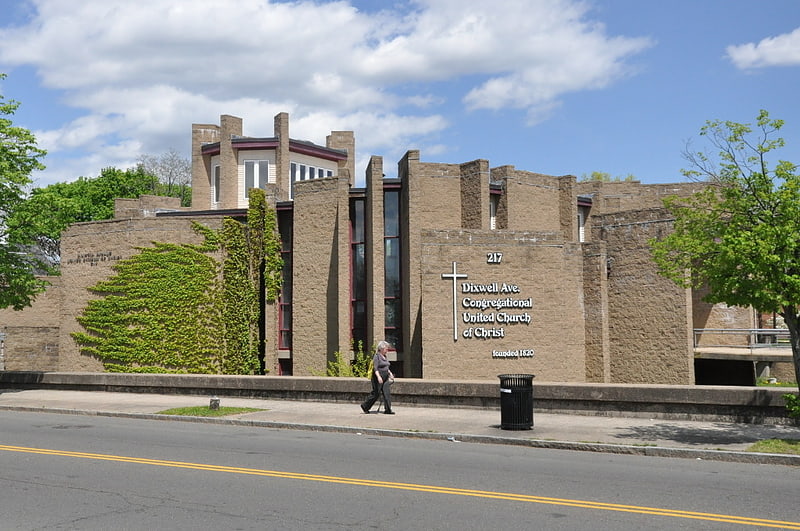
The Dixwell Avenue Congregational United Church of Christ is a historic church at 217 Dixwell Avenue in New Haven, Connecticut. Founded in 1820 as the African Ecclesiastical Society, the congregation has been a major part of African-American society in the city since then. Its current church building, completed in 1969, is a major local example of Brutalist architecture, designed by John M. Johansen. It was listed on the National Register of Historic Places for its architecture in 2018.[25]
Address: 217 Dixwell Avenue, New Haven (Central New Haven)
Christ Church
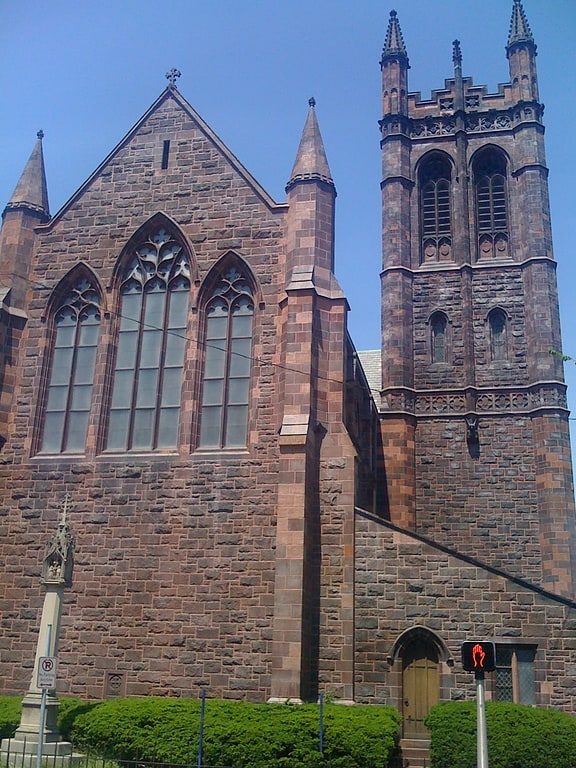
Parish church in New Haven, Connecticut. Christ Church, also known as Christ Church New Haven, is an Episcopal parish church at 70 Broadway in New Haven, Connecticut. Christ Church follows an Anglo-Catholic style of worship and has a strong focus on urban ministry. The parish began as an offshoot from New Haven's Trinity Church, the central Episcopal church on New Haven's town green.
The church building was listed on the National Register of Historic Places in 2009.[26]
Address: 84 Broadway, New Haven (Central New Haven)
St. Mary's Church

Catholic church in New Haven, Connecticut. St. Mary Parish is a Roman Catholic parish in New Haven, Connecticut, part of the Archdiocese of Hartford. The Parish of St. Mary consists of two churches: St. Mary's Church on Hillhouse Avenue, and St. Joseph's Church in the East Rock section of New Haven.
The parish now known as St. Mary's was the first Catholic church in New Haven, and is the second oldest Roman Catholic parish in Connecticut. The parish was originally established in 1832 and the present St. Mary church building is located near Yale University. It is part of the Roman Catholic Archdiocese of Hartford. In 1882, Michael J. McGivney, the church's assistant pastor, founded the Knights of Columbus at the parish. McGivney, whose remains are interred within the church, was beatified by Pope Francis in 2020.
For 135 years, from 1886 until their departure in December 2021, St. Mary's parish had been run by friars of the Dominican Order. In 2021, priests from the archdiocese were assigned as part of major restructuring of parishes in New Haven. In 2018, the parish of St. Mary had previously merged with the nearby parish of St. Joseph as part of an earlier restructuring; both church buildings remain open for regularly schedule worship as part of the consolidated Saint Mary Parish.[27]
Address: 5 Hillhouse Ave, 06511-6815 New Haven (Central New Haven)
Amistad Memorial
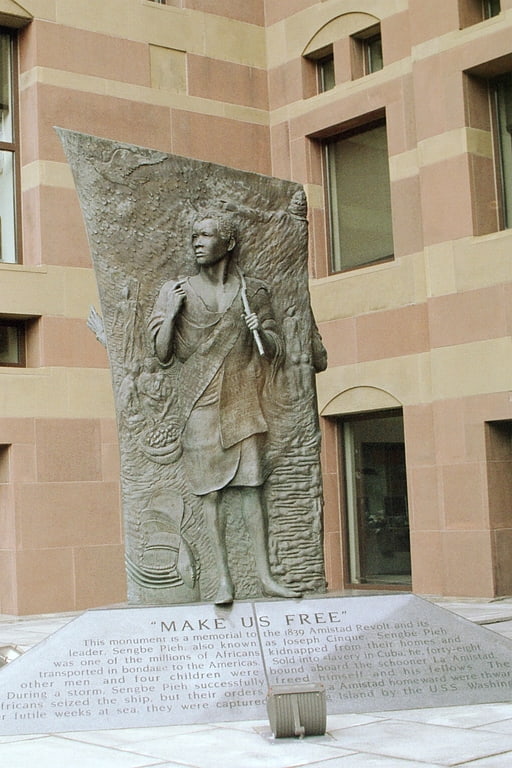
Sculpture by Ed Hamilton. The Amistad Memorial in New Haven, Connecticut is a bronze sculpture created by Ed Hamilton to recognize the events of the 1839 Amistad Affair. The affair was a kidnapping of 53 Africans and their subsequent mutiny aboard La Amistad. It led to a historically significant United States Supreme Court case, in which the Amistad captives were ruled to be acting in self-defense, thereby granting them the right to mutiny.
The memorial sits in front of the New Haven City Hall on Church Street, the location where the Amistad slaves were jailed during their trial. It was dedicated on September 18, 1992.[28]
Yale Repertory Theatre
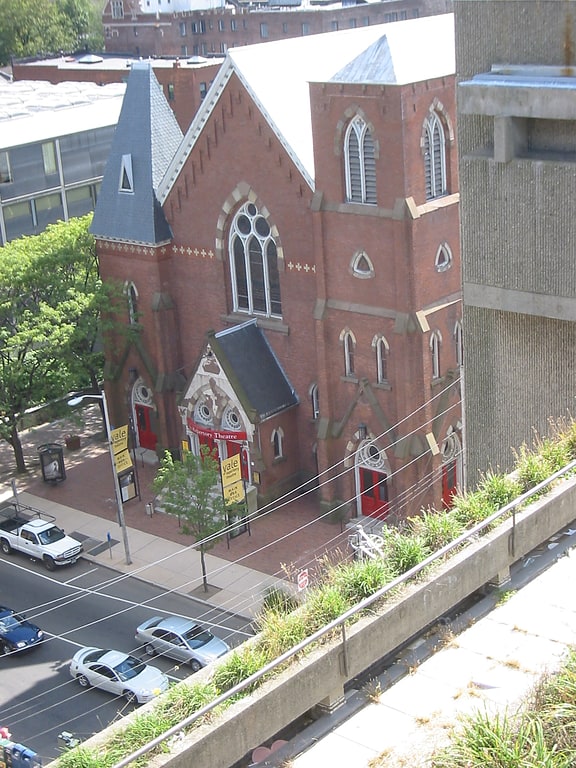
Theatre in New Haven, Connecticut. Yale Repertory Theatre at Yale University in New Haven, Connecticut was founded by Robert Brustein, dean of Yale School of Drama, in 1966, with the goal of facilitating a meaningful collaboration between theatre professionals and talented students. In the process it has become one of the first distinguished regional theatres. Located at the edge of Yale's main downtown campus, it occupies the former Calvary Baptist Church.[29]
Address: 222 York St, 06511-8925 New Haven (Central New Haven)
Dr. Mary B. Moody House
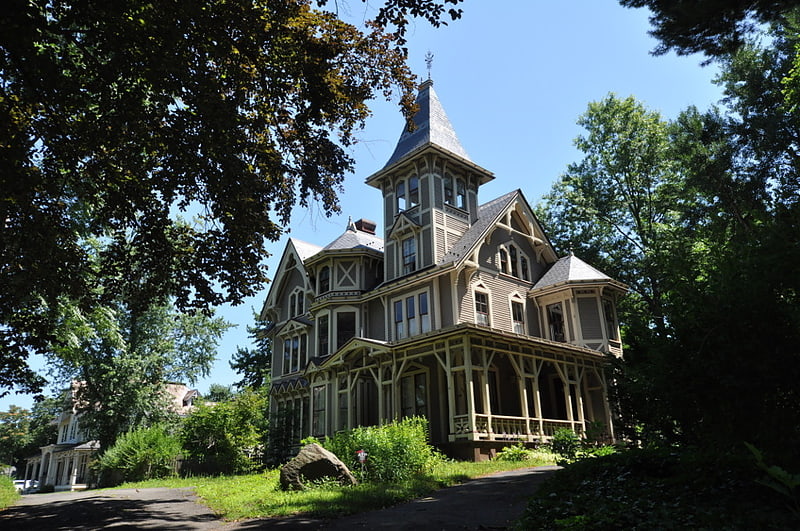
The Dr. Mary B. Moody House, also known as Chetstone, is a historic house at 154 East Grand Avenue in New Haven, Connecticut. Built in 1875, it is one of the city's finest examples of residential Carpenter Gothic architecture, and was home to Dr. Mary Blair Moody, one of the first female physicians to practice in the city. The house was listed on the National Register of Historic Places in 2017.[30]
Yale Collection of Musical Instruments
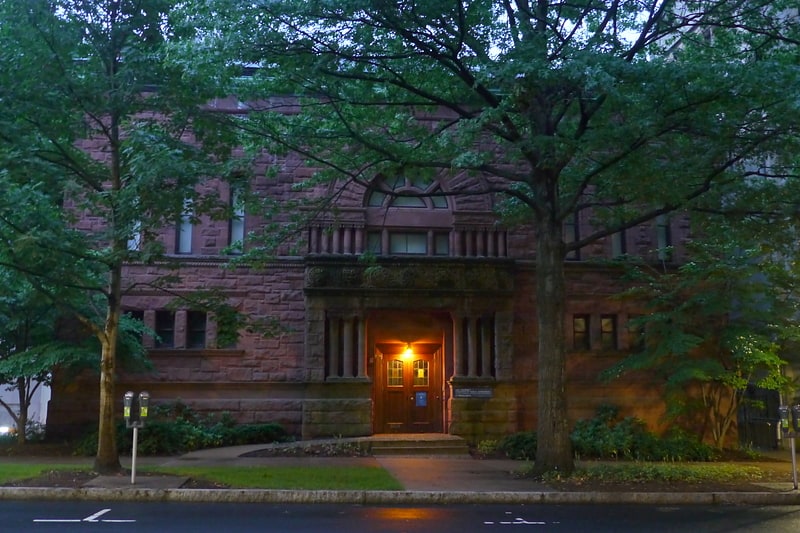
Museum in New Haven, Connecticut. The Yale Collection of Musical Instruments, a division of the Yale School of Music, is a museum in New Haven, Connecticut. It was established in 1900 by a gift of historic keyboard instruments from Morris Steinert, and later enriched in 1960 and 1962 by the acquisition of the Belle Skinner and Emil Herrmann collections. Initially housed under the dome of Woolsey Hall, it was moved in 1961 to a historic Romanesque structure on Hillhouse Avenue, constructed in 1895 for the Alpha Delta Phi fraternity.[31]
Address: 15 Hillhouse Ave, 06511 New Haven (Central New Haven)
Beinecke Rare Book and Manuscript Library
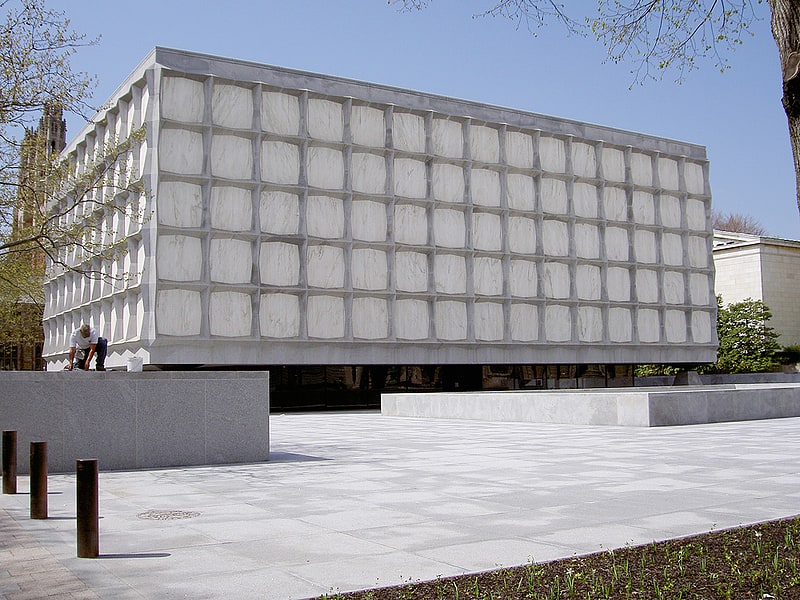
The Beinecke Rare Book & Manuscript Library is the rare book library and literary archive of the Yale University Library in New Haven, Connecticut. It is one of the largest buildings in the world dedicated to rare books and manuscripts. Established by a gift of the Beinecke family and given its own financial endowment, the library is financially independent from the university and is co-governed by the University Library and Yale Corporation.
Situated on Yale University's Hewitt Quadrangle, the building was designed by Gordon Bunshaft of Skidmore, Owings & Merrill and completed in 1963.From 2015-16 the library building was closed for 18 months for major renovations, which included replacing the building's HVAC system and expanding teaching and exhibition capabilities.[32]
Address: 121 Wall St, 06511-8917 New Haven (Central New Haven)
Wooster Square Historic District
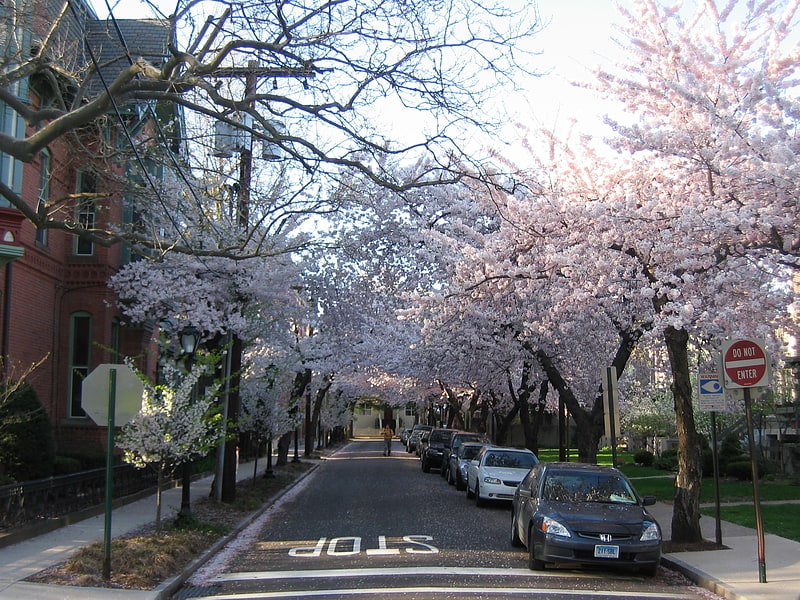
The Wooster Square Historic District encompasses much of the Wooster Square neighborhood of New Haven, Connecticut. Centered on a rectangular park named in honor of General David Wooster, the area was developed as a residential neighborhood beginning in the 1820s, and was by the 1840s a desirable area to live, with many high-quality Greek Revival homes. In the 1950s the area was the subject of a major community-led preservation effort that drew national attention. The district was listed on the National Register of Historic Places in 1971.[33]
Tomlinson Lift Bridge

Bridge in New Haven, Connecticut. The Tomlinson Lift Bridge is a crossing of the Quinnipiac River in New Haven, Connecticut. The bridge forms a segment of U.S. Route 1. The Tomlinson Vertical Lift Bridge carries four lanes of traffic across New Haven Harbor and a single-track freight line owned by the Providence & Worcester Railroad that connects the waterfront with the Northeast Corridor line of Metro North and CSX. A sidewalk is present along the southern edge of the bridge.[34]
Sterling Memorial Library
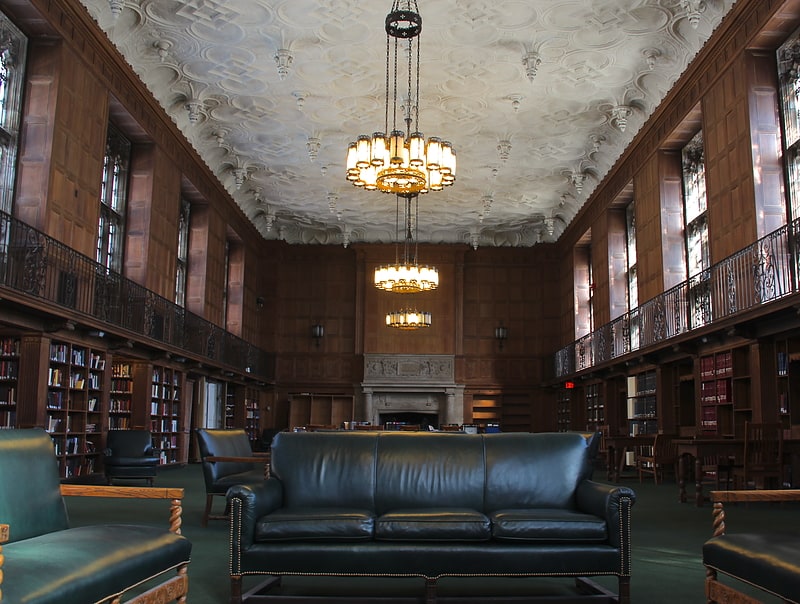
Library in New Haven, Connecticut. Sterling Memorial Library is the main library building of the Yale University Library system in New Haven, Connecticut, United States. Opened in 1931, the library was designed by James Gamble Rogers as the centerpiece of Yale's Gothic Revival campus. The library's tower has sixteen levels of bookstacks containing over 4 million volumes. Several special collections—including the university's Manuscripts & Archives—are also housed in the building. It connects via tunnel to the underground Bass Library, which holds an additional 150,000 volumes.
The library is named for John W. Sterling, a lawyer representing Standard Oil, whose huge bequest to Yale required that an "enduring, useful and architecturally beautiful edifice" be built. Sterling Library is elaborately ornamented, featuring extensive sculpture and painting as well as hundreds of panes of stained glass created by G. Owen Bonawit. In addition to the book tower, Rogers' design featured five large reading rooms and two courtyards, one of which is now a music library.
While the library's nave and main reading rooms can be visited on guided tours, its collections are restricted to cardholders.[35]
Address: New Haven, 120 High Street